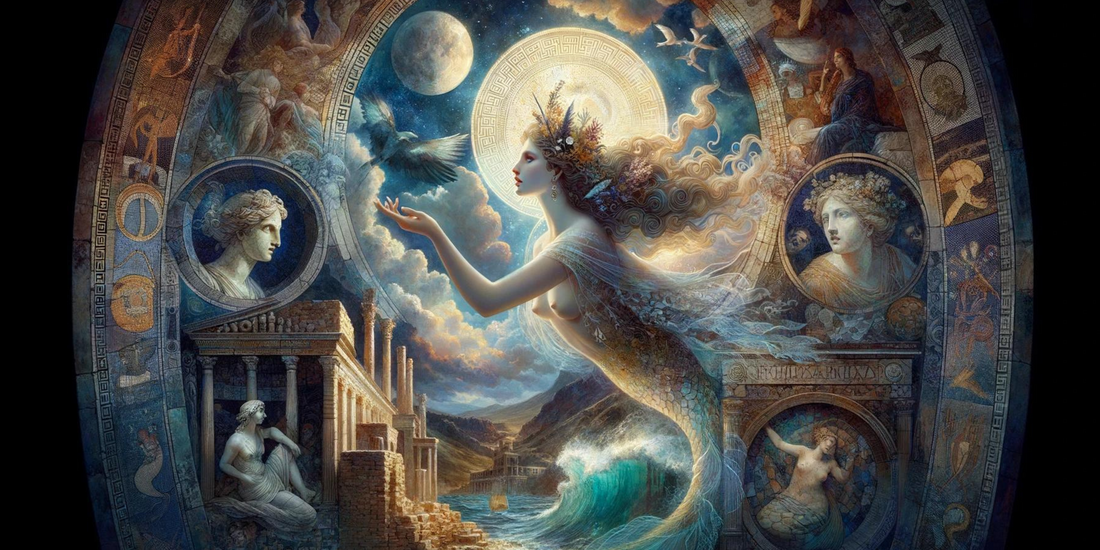Introduction to Sirens in Art and Culture
The captivating allure of sirens has been a focal point in art and culture, weaving a complex tapestry that spans across eras and civilizations. From their mythological origins to their symbolic representations in various cultures, sirens have consistently been depicted as enigmatic entities, oscillating between benevolence and malevolence.
Unveiling the Myth: The Origin of Sirens
The journey into the world of sirens begins in the ancient Greek mythology, where they were first described as creatures with the head of a woman and the body of a bird. These mythical beings were known for their hauntingly beautiful songs that lured sailors to their doom. The transformation of sirens from Greek mythology to a global legend showcases their enduring appeal and the human fascination with the mysterious and the unknown.
The Symbolism of Sirens in Ancient Cultures
In various ancient cultures, sirens were more than just mythical creatures; they were symbolic representations of both temptation and guidance. They were often seen as omens of what was to come, and in some contexts, as protectors guiding souls to the afterlife. This duality in their nature reflects the complex human emotions and challenges the notion of binary good and evil.
The Allure of Sirens in Ancient Art
The depiction of sirens in ancient art provides invaluable insights into how these mythical creatures were perceived by different civilizations.
Sirens in Greek Pottery and Mosaics
Greek pottery and mosaics offer a visual narrative of the siren mythology, with intricate designs portraying these beings in various mythological scenes. The iconography used in these artworks provides a window into the ancient Greek’s interpretation of sirens, highlighting their role within the mythological framework.
Roman Adaptations: Sirens in Sculptures and Frescoes
The Roman empire, known for its adaptation and expansion of Greek mythology, introduced sirens in their sculptures and frescoes. This marked a significant transformation in the siren image, with the depiction shifting from bird-like creatures to mermaid-like figures with human heads and fish tails. This evolution in art reflects the dynamic nature of mythological interpretations.
Literary Echoes: Sirens from Homer to the Modern Day
The portrayal of sirens has permeated literature, evolving with each era, yet maintaining the core essence of their mythical origin.
The Odyssey: The Quintessential Siren Tale
Homer’s Odyssey is perhaps the most iconic literary work that features sirens. This epic poem not only introduces sirens to a wider audience but also sets the foundation for their mythological significance. The analysis of the sirens' song in the Odyssey reveals the deep-seated human fears and desires that these creatures symbolize.
Sirens in Medieval and Renaissance Literature
Throughout the Medieval and Renaissance periods, sirens transitioned from mere mythological creatures to symbols of temptation and spiritual peril. This period saw a fusion of pagan myths with Christian symbolism, where sirens were often depicted as temptresses leading men away from the path of righteousness.
The Sirens of Titan: Vonnegut's Cosmic Sirens
Kurt Vonnegut’s The Sirens of Titan offers a modern and cosmic take on the siren lore. This science fiction masterpiece reimagines sirens within the vast expanse of the universe, expanding their realm from the sea to the cosmic shores, thus showcasing the versatility and endurance of siren mythology in contemporary literature.
Sirens of the Sea: Nautical Legends and Folklore
The nautical legends and folklore of various cultures are rich with tales of sirens, each offering a unique perspective on these enchanting beings.
Sirens in Maritime Mythology
The lore of sirens is deeply entwined with maritime mythology, with countless tales from sailors and explorers who spoke of encounters with these mesmerizing creatures. These stories often serve as cautionary tales, highlighting the perils of the sea and the irresistible allure of the unknown.
The Evolution of Sea Sirens in Folklore
Over time, the portrayal of sea sirens in folklore has evolved from malevolent predators to benevolent protectors of the sea and its creatures. This transformation reflects changing human attitudes towards the ocean, from a fearful view of the unknown to a respectful and protective stance towards marine life. An intriguing figure in the lore of sea deities that complements this narrative is Atargatis, often considered the first mermaid in mythology. Her story, embodying the dual nature of nurturing and perilous aspects of the sea, provides a deeper understanding of how ancient cultures perceived these enigmatic beings. For a comprehensive exploration of Atargatis and her significance in the pantheon of sea deities, discover more about this enigmatic mermaid goddess.
Contemporary Depictions: Sirens in Modern Media and Art
In the realm of modern media and art, sirens continue to be a source of inspiration, adapted and reinterpreted to fit contemporary narratives.
Sirens in Film and Television
Modern film and television have embraced the siren myth, often providing a twist on the ancient stories. These adaptations explore the multifaceted nature of sirens, portraying them as complex characters that defy the traditional good vs. evil dichotomy.
The Siren's Influence on Modern Literature and Music
The siren motif remains a popular theme in modern literature and music, serving as a metaphor for desire, obsession, and the pursuit of the unattainable. This continued relevance highlights the universal themes embedded in the siren lore, resonating with audiences across generations.
The Siren's Influence on Cultural Identity and Feminism
The figure of the siren has also played a significant role in discussions of cultural identity and feminism, serving as a symbol of female empowerment and autonomy.
Sirens as Empowerment Symbols
In the context of feminism, sirens have been reclaimed as symbols of strength, independence, and female agency. This reimagining of sirens challenges their traditional portrayal as mere objects of male desire, presenting them instead as empowered beings in control of their own destiny.
The Siren in Gender Studies and Cultural Analysis
The study of sirens in gender studies and cultural analysis offers a multifaceted view of these creatures, exploring their role as cultural symbols that reflect shifting societal norms and attitudes towards gender and identity.
Overview and Concluding Thoughts
The exploration of sirens across art, literature, and culture reveals their enduring legacy and the timeless fascination they hold. The siren's call, transcending time and mediums, continues to captivate and inspire, serving as a testament to the power of mythology and the human imagination.
Related FAQs
What is the true nature of the siren's song?
The siren's song represents the complex interplay between desire and danger, symbolizing the human quest for the unknown despite inherent risks.
How have sirens been portrayed differently in various cultures?
Sirens have been depicted in a multitude of ways, from harbingers of doom to guardians of the deep, reflecting the diverse cultural interpretations and attitudes towards these mythical beings.
Can sirens be found in cultures outside of Europe?
Yes, many cultures around the world have similar mythological figures that embody the dual nature of allure and peril, showcasing the universal appeal of such myths.
How do modern interpretations of sirens challenge their traditional portrayals?
Modern interpretations often subvert traditional portrayals, presenting sirens as complex characters with agency and depth, thus challenging stereotypical views and expanding their narrative scope.





